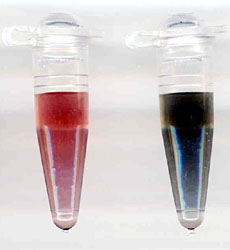
Sorting Carbon Nanotubes
 A collaborative group of DuPont-led scientists have discovered an innovative way to advance electronics applications through the use of DNA that sorts carbon nanotubes.
A collaborative group of DuPont-led scientists have discovered an innovative way to advance electronics applications through the use of DNA that sorts carbon nanotubes.
This research in the emerging field of nanotechnology appears in the current issue of the journal Science, which is published by the AAAS -- the world's largest general scientific organization. The research paper is titled "Structure-Based Carbon Nanotube Sorting by Sequence-Dependent DNA Assembly."
Carbon nanotubes possess excellent electrical properties that make them potential building blocks in a broad range of nanotechnology-related electronic applications, including highly sensitive medical diagnostic devices and mini-transistors more than 100 times tinier than those found in today's microchips. When they are fabricated, however, carbon nanotubes of different electronic types randomly clump together, deterring consistent conductivity. The ability to sort and assemble carbon nanotubes allows for uniform conductivity -- enabling the applications to be realized.
Initially, DuPont Central Research & Development scientists found that single-stranded DNA strongly interacts with carbon nanotubes to form a stable DNA-carbon nanotube hybrid that effectively disperses carbon nanotubes in an aqueous solution.
As a follow-up to that initial work, a multidisciplinary team of scientists from DuPont, the Massachusetts Institute for Technology (MIT) and the University of Illinois worked together to discover a new method for separating carbon nanotubes using single stranded DNA and anion-exchange chromatography. By screening a library of oligonucleotides, the team found that a particular sequence of single stranded DNA self-assembles into a helical structure around individual carbon nanotubes. Since carbon nanotube- DNA hybrids have different electrostatic properties that depend on the nanotubes' diameter and electronic properties, they can be separated and sorted using anion exchange chromatography. The technique can be used to separate metallic carbon nanotubes from semiconducting carbon nanotubes, both which are created during nanotube production. The technique also can sort semiconducting carbon nanotubes by diameters, an important element in nanoelectronic applications. The collaborative work is further detailed in the current edition of Science.
"Wrapping of carbon nanotubes by single-stranded DNA was found to be sequence-dependent," said DuPont Central Research & Development scientist Ming Zheng. "This outstanding collaborative effort is a good example how researchers from both industry and academic institutions can work together in a multidisciplinary approach to further advance this emerging technology."
DuPont offers a wide range of products and services to markets including agriculture, nutrition, electronics, communications, safety and protection, home and construction, transportation and apparel.